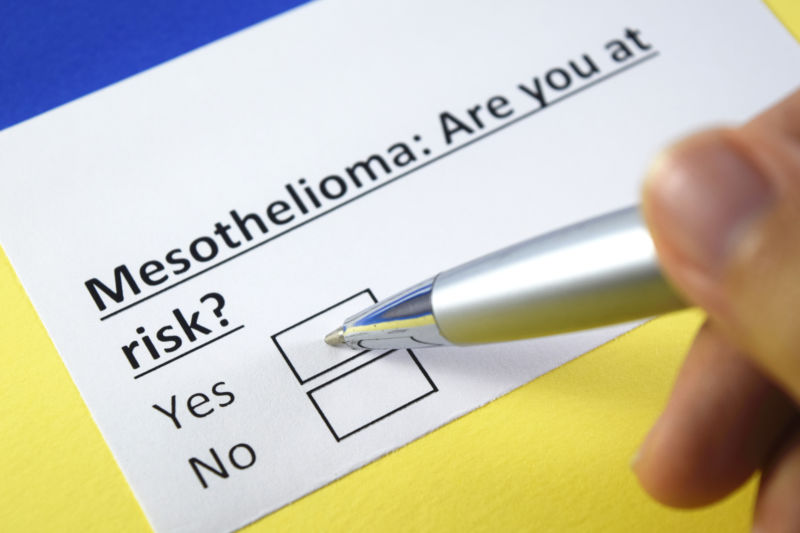Mesothelioma is an incurable and relatively aggressive type of cancer that typically affects the lining of the lungs. Mesothelioma is almost always caused by asbestos exposure, although this exposure could occur several decades before your diagnosis.
Before we fully understood the dangers of asbestos, manufacturers used it in thousands of consumer products including tile and insulation, roofing materials and household goods. Over time, these products aged and began to break down, releasing millions of microscopic fibers that, when inhaled or swallowed, embedded in your lung tissue and eventually caused cancer.
About Mesothelioma
Mesothelioma can sometimes take several decades to develop and become symptomatic. The symptoms often resemble a cold or allergies at first, and many people simply shrug it off as no big deal. However, early detection plays an important role if one is to survive this type of aggressive cancer. According to the National Cancer Institute, most people die within two years of receiving their diagnosis, and 90 percent do not survive five years. Early detection can extend this time, especially if surgery is possible to treat your cancer.
The extremely long latency period between exposure and diagnosis makes it difficult to link the cancer with your exposure. Worker cases are generally easy to link; this is because workers handled the asbestos materials all the time and had near-constant exposure. Most people who develop mesothelioma were young, blue collar workers when they worked with or handled the asbestos, but the average age of diagnosis is 69, according to the National Cancer Institute.
While the most common mesothelioma affects the lining of the lungs, the pleural, there are two others:
- Peritoneal Mesothelioma: Airborne asbestos fibers embed themselves in the abdomen and cause cancer here.
- Pericardial Mesothelioma: Airborne asbestos fibers embed themselves in the heart and cause cancer here.
All three types of mesothelioma are almost exclusively linked to asbestos exposure.
Treatment for all three types of mesothelioma typically involve surgery, radiation, and chemotherapy. There are also clinical trials available for patients who do not respond to more traditional treatments. Some diagnosed with Stage III or IV opt for palliative care instead of facing months of treatment that may not extend their life more than a few weeks.
About Asbestos
Builders and manufacturers used asbestos in a number of household products beginning in the 1860s until the late 1970s and early 1980s. This white, fibrous mineral is an excellent insulator, and could withstand temperature changes and even high amounts of electricity. Some of the most common asbestos-containing products included:
- Brake and clutch pads;
- Cements and spackle;
- Fireproof materials;
- Tiles;
- Insulation;
- Paints and spackles;
- Pipes and pipe insulation;
- Plastics;
- Roofing;
Many people who develop mesothelioma worked in an industry where they came in contact with these products regularly, or handled asbestos materials daily. This includes builders, contractors, painters, and a number of other blue collar workers. Some people also suffer from mesothelioma after second hand exposure, such as a wife who handled her husband’s work clothing, or a family who shared the same car regularly.
Collecting Compensation For Your Losses
You likely have a case against the manufacturer of the asbestos products that caused your cancer. There are several legal options for those who developed mesothelioma because of asbestos exposure. To pursue any of these options, we will need to identify when and where you inhaled the asbestos. We also need to work quickly, because some states give you as little as a year after diagnosis to file litigation to collect the money owed to you.
To collect compensation, whether through a lawsuit against the company or from an asbestos trust fund established by a now-defunct manufacturer, we need to tie your mesothelioma to your asbestos exposure, and identify the liable party. This sometimes requires locating records from forty years ago — or more.
If we can document your exposure and prove liability, we can request compensation to cover a wide range of losses for you. This may include:
- The cost of medical treatment
- Lost wages
- Other illness-related expenses
- Pain and suffering
In addition to filing a claim based on your illness, we also accept claims from the family members of someone who already lost their life to mesothelioma. We can file a wrongful death case on their behalf, and collect many of the same damages.
Talk to a Mesothelioma and Asbestos Lawyer
At Gacovino, Lake & Associates, P.C., our attorneys understand that you need compensation to help pay your medical bills and other costs related to your cancer treatment. We fight to help you recover the money you deserve, either through a lawsuit against the company or applying for money from one of the asbestos funds set up by bankrupt asbestos companies. Call us today at 800-550-0000 and schedule a time to discuss your case with one of our mesothelioma lawyers.
